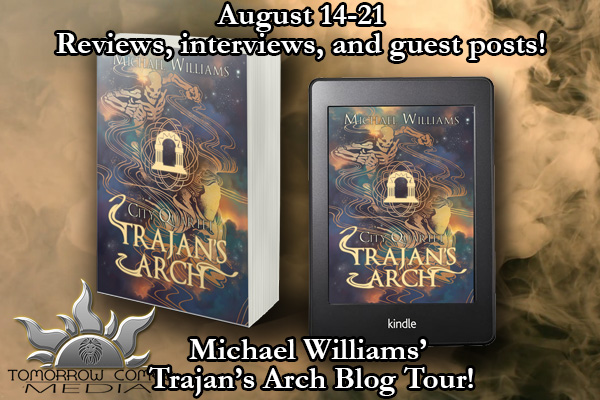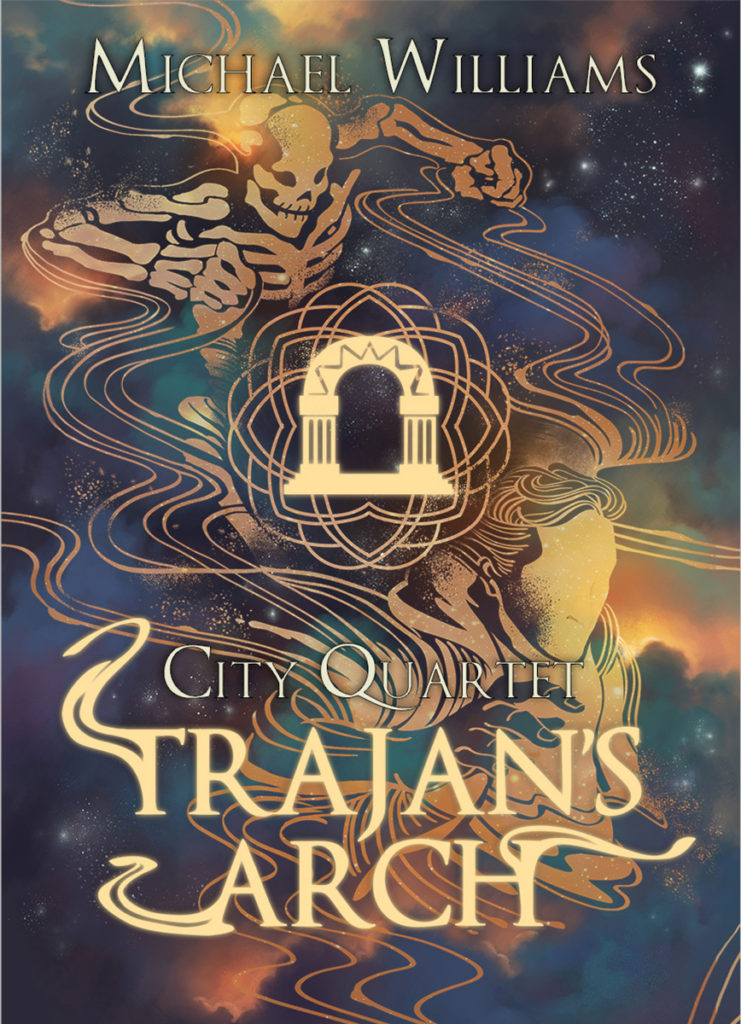What is Magical Realism?

Today I'm joining in with an immersive and enthralling experience in magical realism and mythic fiction in celebration of the release of Trajan's Arch, by Michael Williams! And the author is here, on my blog, to let us know his take on magical realism. So grab a coffee, tea, beer... whatever suits... and over to you Michael.
Magical Realism
The term
“magical realism” is a kind of fuzzy set, so it’s no accident that a good
definition has always been the subject of dispute. A lot of people I know in the speculative
fiction communities are upset by the term, and for understandable reasons: they
believe it’s a kind of leftover snobbery, a way for established mainstream
writers to work in the fantastic mode without being associated with speculative
fiction.
But literary
condescension aside, I do see magical realism as something a little different
from fantasy or horror—different, in fact, from more critically established
modes such as expressionism or surrealism, when you come right down to it. “Magical realism” is a term coined because a
term was needed.
As I
understand it—my contribution to the fuzzy set—magical realism is a kind of
storytelling that mingles the fantastic and the realistic without giving priority to either mode. Good magical realist art presupposes our
shared consensus reality, then destabilizes or undermines or questions that by
the allowing the fantastic to exist side-by-side with the everyday in the world
of the story or painting or film. The
trick is that the fantastic is regarded with equal power and acceptance to the
nearby world, setting, and situations we would generally call that of
realism. No flight to Narnia, no
Lovecraftian settings, and certainly no alternate worlds like Middle Earth or
Westros—these abide in the realm of the marvelous, and they are professedly not
our world, or they are a part of our world that we travel to in part by leaving
behind our consensus reality.
Some
maintain that this is essentially urban fantasy. I would suggest, however, that some urban
fantasy (a category established later than that of magical realism, and itself
a fuzzy set), derives from magical realism.
In fact, urban fantasy is as difficult (if not more difficult) to
describe than its magical realist predecessor: the clear vision of Emma Bull,
John Crowley, and Charles de Lint has been replaced on the shelves by urban
fantasy almost indistinguishable from paranormal romance.
In turn,
Surrealism and Expressionism are artistic modes that, in my understanding,
arise from the mind’s interaction with the big world out there. In the dream of Surrealism and the profound
emotion and psychology of Expressionism, wonder is projected onto the things
around us. Magical realism assumes that
the wonder is already in those things—that the specific, concrete outer world
contains its own magic, waiting for us to discover.
So instead
of defining magical realism, we might do better to define its elements. Wendy Faris, one of the preeminent scholars
in the field, describes the mode as follows:
As a basis for investigating the nature and cultural work of
magical realism, I suggest five primary characteristics of the mode. First, the
text contains an "irreducible element" of magic; second, the
descriptions in magical realism detail a strong presence of the phenomenal
world; third, the reader may experience some unsettling doubts in the effort to
reconcile two contradictory understandings of events; fourth, the narrative
merges different realms; and, finally, magical realism disturbs received ideas
about time, space, and identity.
And yes, you
can find some of these elements in other forms of storytelling. At risk of repeating myself, though, I would add
to Dr. Faris’s list by emphasizing what I said above: the key to what makes the
story magical realist is that it values its magic and its realism equally, that
it expects its audience (because it’s not only reading but visual art and film)
to value the two qualities equally.
Trajan’s Arch was the first of my magical realist
books. The central story of a boy’s
coming-of-age exists beside the haunting—both supernatural and natural—he
carries into adulthood. Spread out over
the novel is the magic of ghosts and of memory, of fiction intruding on the
real world and of the real world intruding on the contained, hermetic worlds of
fiction. If you’re looking for an
example of what I mean by magical realism—how I do it as a writer—I refer you
to the first story-within-a-story of the novel: “Giuoco Piano,” written by
Trajan Bell, who in turn was written by me.
Thank you, Michael. That "equal priority" concept will stick with me, and help me decide where the book I'm working on fits. And I'm very much looking forward to reading Trajan's Arch.

About the author:
Over the past 25 years, Michael Williams has written a number of strange novels, from the early Weasel’s Luck and Galen Beknighted in the best-selling DRAGONLANCE series to the more recent lyrical and experimental Arcady, singled out for praise by Locus and Asimov’s magazines. In Trajan’s Arch, his eleventh novel, stories fold into stories and a boy grows up with ghostly mentors, and the recently published Vine mingles Greek tragedy and urban legend, as a local dramatic production in a small city goes humorously, then horrifically, awry.
Trajan’s Arch and Vine are two of the books in Williams’s highly anticipated City Quartet, to be joined in 2018 by Dominic’s Ghosts and Tattered Men.
Williams was born in Louisville, Kentucky, and spent much of his childhood in the south central part of the state, the red-dirt gothic home of Appalachian foothills and stories of Confederate guerrillas. Through good luck and a roundabout journey he made his way through through New England, New York, Wisconsin, Britain and Ireland, and has ended up less than thirty miles from where he began. He has a Ph.D. in Humanities, and teaches at the University of Louisville, where he focuses on the he Modern Fantastic in fiction and film. He is married, and has two grown sons.
Where to Find Him:
Facebook: https://www.facebook.com/Mythical-Realism-The-Michael-Williams-Page-128713900543978/

About Trajan’s Arch:
Part of Michael's visionary City Quartet, this stand-alone novel flows with literary grace telling the story of Gabriel Rackett and his possession of a manuscript that will take him on a journey both profound and deeply personal as he confronts old ghosts and his own coming of age.
A great story that is part of a broader, visionary literary project from Michael Williams, Trajan's Arch will bring you a unique and enjoyable reading experience!
Gabriel Rackett stands at the threshold of middle age. He lives north of Chicago and teaches at a small community college. He has written one novel and has no prospects of writing another, his powers stagnated by drink and loss. Into his possession comes a manuscript, written by a childhood friend and neighbor, which ignites his memory and takes him back to his mysterious mentor and the ghosts that haunted his own coming of age. Now, at the ebb of his resources, Gabriel returns to his old haunts through a series of fantastic stories spilling dangerously off the page--tales that will preoccupy and pursue him back to their dark and secret sources.
Where to Find Trajan’s Arch
Kindle Version: https://www.amazon.com/Trajans-Arch-Michael-Williams-ebook-dp-B07RD1RF9T/dp/B07RD1RF9T/
Amazon Print Version: https://www.amazon.com/Trajans-Arch-Michael-Williams/dp/1948042754/
Barnes and Noble Link: https://www.barnesandnoble.com/w/trajans-arch-michael-williams/1100075829?ean=9781948042758
Find out more: Follow the tour!
8/14 Armed with a Book http://www.armedwithabook.com Review
8/14 I Smell Sheep http://www.ismellsheep.com/ Guest Post
8/15 Horror Tree https://www.horrortree.com Guest Post
8/16 The Seventh Star Blog http://www.theseventhstarblog.com Top 10
8/17 The Literary Underworld http://www.literaryunderworld.com Guest post
8/18 Jazzy Book Reviews http://bookreviewsbyjasmine.blogspot.com Author Interview
8/19 Sheila's guests and reviews http://sheiladeeth.blogspot.com Guest Post
8/19 Armed with a Book http://www.armedwithabook.com Interview
8/20 Stuart Conover's Homepage https://www.stuartconover.com Guest Post
8/21 The Sinister Scribblings of Sarah E. Glenn https://saraheglenn.blogspot.com/ Author Interview and possible review
Comments